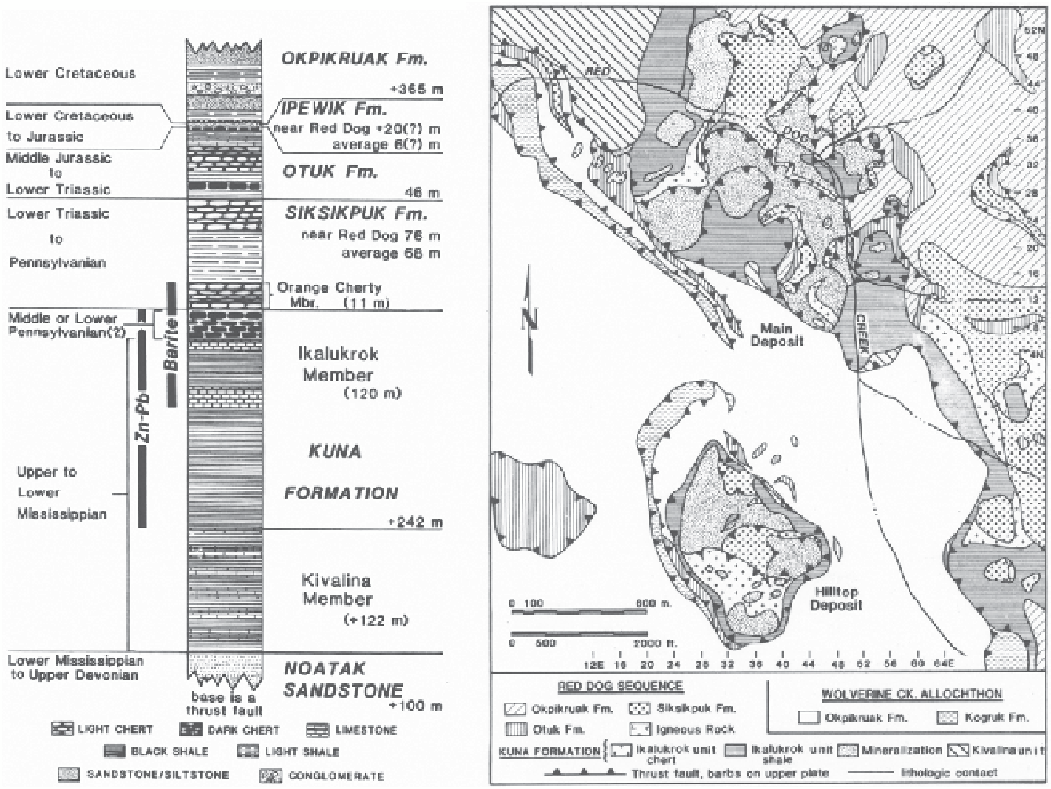Geoscience Reference
In-Depth Information
Fig. 14.40
Stratigraphic section of the Red Dog sequence (left) and bedrock geology for the Main and Qanaiyaq (Hilltop) deposits (right). (Moore
et al.
1986
)
and sulfide-poor barite of the lower Siksikpuk Formation of
Pennsylvanian to Permian age (Moore et al.
1986
). A strati-
graphic section and geologic map can be seen in Fig.
14.40
.
The main deposit is a nearly flat, elongated stack of three
significantly mineralized lenses. It extends 1,600 m in a
northwest direction, varies in width from 150 m to 975 m
and is up to 135 m thick. The main deposit consists of two
major and one minor mineralized plates and their associ-
ated overlying waste rocks. The upper plate is a flat-lying
sheet of Kivalina unit limestone and shale, Ikalukrok unit
siliceous shale and sulfide-bearing barite rock. The median
plate contains most of the resources in this zone and con-
sists of a sequence of massive to semi-massive sulfide rock,
sulfide-bearing silica rock and sulfide-bearing barite rock.
The mineralized portion of the median plate is capped with
a sequence of shale and chert of Siksikpuk, Otuk and Okpi-
kruak units. The lower plate mineralization in the Main de-
posit consists of sulfide-veined, silicified, Ikalukrok shale,
semi-massive to massive sulfides, and sulfide-bearing bar-
ite rock.
14.4.1
Geology and Database
The Red Dog deposits are SEDEX, zinc-lead-silver deposits
hosted in Mississippian- to Pennsylvanian-age black shale.
The deposits are found in the De Long Mountains, which are
made up of eight stacked and folded allochthons, sedimen-
tary material that has been moved (thrusted) from its original
position. The six structurally lowest allochthons are com-
posed of Devonian through to Cretaceous clastic and chemi-
cal sedimentary rocks, while the two upper allochthons are
of Jurassic and older age and are made of mafic to ultramafic
igneous sequences (Moore et al.
1986
).
Mineralization is found in the second lowest allochthon
hosted by black siliceous shale and chert of the Ikalukrok
unit of the Kuna Formation. The stratigraphic footwall is an
interbedded, light gray, calcarenite and dark gray calcare-
ous shale, the Kivalina unit. The deposits themselves are a
strata-bound accumulation of siliceous rock, barite and sul-
fides. The hanging wall unit to the mineralization is a silica-

